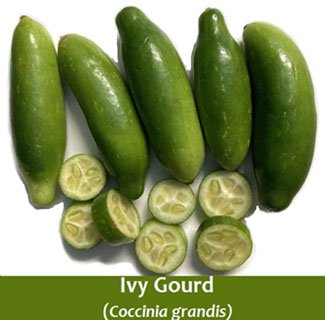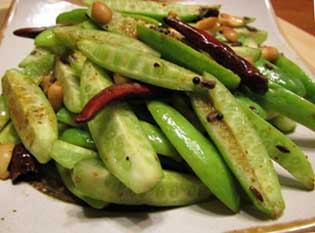Ivy gourd (Kundru) Nutrition facts
Ivy gourd, also known as kundru or Tindora, is a nutrient-rich fast-growing perennial vine plant of the Cucurbitaceae family. In southern Asia, the ivy gourd is cultivated for its long slender edible young shoots and immature, tender fruits.
The fruits possess a neutral, bland taste like a cucumber, and are used in the preparation of various vegetable dishes.
Family: Cucurbitaceae, Genus: Coccinia. Scientific name: Coccinia grandis.
 |
Kundru is a fast-growing, dioecious, perennial climber (trailing vine) with glabrous stems and tuberous roots. It grows well in tropical climates and sometimes as an invasive crop. Well-draining, loose, and porous soil is preferred for ivy gourd cultivation. In India and Sri Lanka, it is grown as a cultivated plant in home gardens.
Its heart to pentagon-shaped, and large leaves are arranged alternately along the stems. The upper surface of the leaf is hairless, whereas the lower is hairy and has simple tendrils. Flowers are star-shaped, large, and white in color.
Fruits appear on stalks after about 3 months; ovoid to elliptical, 25-60 mm long, 15-35 mm in diameter, smooth-surface, hairless. Inside, the flesh is almost transparent, and tiny, tender seeds about 6-7 mm long are arranged along the length of the fruit. Seeds are edible in immature fruits.
In immature fruits, the skin is green with vertical pale patterns on the surface. Ripe fruits appear scarlet red color.
The Ivy gourd fruit is used as a vegetable when green and eaten fresh when ripened into a bright scarlet color. Young leaves and long slender stem tops - cooked and eaten as a potherb or added to soups.
Health benefits of Ivy gourd
Ivy gourd is a very low-calorie Cucurbitaceae vegetable. 100 grams (3.5 oz) of raw fruit holds 21 calories, almost the same as for Ridge gourd (20 cal). Besides, it carries no saturated fats or cholesterol. Its peel is a good source of dietary fiber.
It is a good source of dietary fiber which helps in smooth bowel movements and offers protection against colon cancers by eliminating toxic compounds from the gut.
Ivy gourd is a gluten-free vegetable item. It can be a good substitute for gluten-sensitive (celiac disease) people.
It is rich in lycopene (5.68 mg / 100 g), and beta-carotene (2.24 mg / 100 g). The other flavonoid poly-phenolic antioxidants such as alpha-carotenes, lutein, and zeaxanthin.
Together with vitamin-A, pigment compounds help scavenge harmful oxygen-derived free radicals and reactive oxygen species (ROS) from the body that play a role in aging and various disease processes.
Ivy gourd fruit also has less sodium but contains good amounts of potassium, an important intra-cellular electrolyte. Potassium is a heart-friendly electrolyte that helps in decreasing blood pressure and heart rates by countering the pressing effects of sodium.
Further, ivy gourd carries modest levels of other B-complex groups of vitamins like pantothenic acid, riboflavin, and minerals like calcium (24 mg/100g), iron (0.9 mg/100 g), manganese, phosphorus, and zinc.
Medicinal values of Ivy gourd
It is a wonderful vegetable plant species having various pharmacological properties like analgesic, antipyretic, anti-inflammatory, antimicrobial, antiulcer, antidiabetic, antioxidant, hypoglycemic, hepatoprotective, antimalarial, antidyslipidemic, anticancer, antitussive, mutagenic.
Some of the chemical compounds having medicinal properties in ivy gourd are ellagic acid, terpenoids, lignin, other compounds like alkaloids, tannins, flavonoids, glycosides, phenols, B-amyrin acetate, lupeol, taraxerol,ß, Bcarotene, lycopene, cryptoxanthin, xyloglucans, carotenoids, and ß-sitosterol.
| Principle | Nutrient Value | Percent of RDA |
|---|---|---|
| Energy | 21 Kcal | 1% |
| Carbohydrates | 3.4 g | 2.6% |
| Protein | 0.2 g | 1% |
| Total Fat | 0.2 g | 1% |
| Cholesterol | 0 mg | 0% |
| Dietary Fiber | 2.9 g | 7.6% |
| Minerals | ||
| Calcium | 24 mg | 2.4% |
| Iron | 0.9 mg | 11% |
| Phyto-nutrients | ||
| Carotene-β | 2.24 mg | -- |
| Lycopene | 5.68 mg | -- |
Buying and storage
In the tropics, ivy gourd is available all around the seasons. Look for fresh, tender kundru/tendli in the local farmer markets. Choose green, immature, firm pods with bump-like, prominent stem ends.
Avoid oversize, ripe/mature, sunken, and flabby fruits as they may be a sign of old stock and flavorless. Also, avoid those with surface cuts, cracks, bruised, or broken.
Fresh kundru veggies are stored well if kept in the refrigerator. At home, store them in the vegetable compartment of the refrigerator, and should be used within two or three days of purchase before they begin to sunken.Preparation and serving methods
Wash in clean water to rid of any surface dirt and sand. No need to scrape them. The skin of immature fruits is edible. Slice the fruit of the desired size using a paring knife. Like in squashes and gourds, kundru should not be overcooked.
Ivy gourd has a mild, delicate flavor and soft texture; very similar to that of cucumber, or bottle gourd. It is used mostly in stir-fried dishes or curries/soups. It goes particularly well with lentils in lentil curry and mixed-vegetable stews.
 |
| Tindora masala. Photo credit: John Thompson |
Here are some serving tips:
In Northern India, Pakistan, and Nepal, ivy gourd is popularly called as kundru or tendli, It is employed in stuffed sabzi, stews, and soups.
Ivy gourd is a common vegetable featuring in curries/Palya/stews in many parts of South Indian states.
In Maharashtra and Gujarat, ivy gourd is known as tondli and tindora respectively. Spice-mix stuffed Bharela tindora is a popular recipe in these regions.
Its tender leafy tips, and tendrils are equally popular and used as greens in the dishes.
In Tamilnadu, where this vegetable is a large crop, ivy gourd is known by the local name kovakkai. Immature, green fruits used in kovakkai fry and kovakkai chutney and served with steamed rice.
Safety profile
Ivy gourd consumption rarely causes allergic reactions.
Often, some ivy gourd fruits can be bitter due to terpenoid toxic compounds such as cucurbitacin B, D, G, H,, etc.
If found, discard the whole fruit. In a case of discomfort after consumption (nausea, vomiting, diarrhea, or any feeling of uneasiness), one needs to seek immediate medical attention. (Medical disclaimer).
Also read ≻≻-
≻≻-Crookneck squash nutrition facts.
≻≻-Bottle gourd nutrition facts.
≻≻-Back to Vegetables from Ivy gourd (Kundru) nutrition. Visit here for an impressive list of vegetables with complete illustrations of their nutrition facts and health benefits.
≻≻-Back to Home page.
Further reading:
International Journal of Chemical StudiesNutritional and therapeutic values of Coccinea grandis: A review.